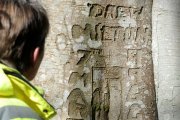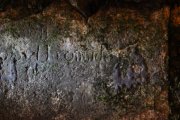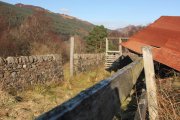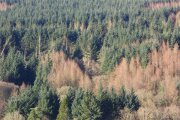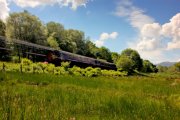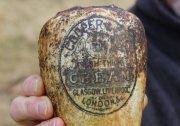Modern
Although called 'modern', memories and features in the landscape dating from the 1900s are vital to understanding our heritage...it won't be long until they are part of our 'ancient history'!
An inscription on a cement block opposite the cenotaph near Tigh Vectican is a glimpse into this personal, modern history. Lomond School pupils had tried taking rubbings from the indecipherable scratches, with no luck, but after taking torches and a camera out at night to photograph the plaque, we think we might have solved this mystery. Etched into the stone, a discernible 'Ironside' can be seen (see image left). This seems to be evidence of a love story that local people had heard about. Jock McGourlay lived at Tigh Vectican and Isobel Ironside lived at Fern Cottage; they would probably have been born during World War I and later got married. At some point in their lives we think they etched their names into the plaque at the top of the 'back road'. Was there something written on the cement before they did this, or did they create this plaque for themselves? We will probably never know...
Recreation and Dumping: The isthmus has seen a golf course in the early 1900s and a rubbish tip in the mid 1900s come and then go. Today, forestry tracks and the Three Lochs Way traverse the isthmus, enabling us to walk across this 'corridor' of land as people have done for many hundreds of years.
Landscape and Industry: The spectacular mountain scenery surrounding the area today attracts visitors from far and wide also has more practical applications. The UK’s largest conventional hydroelectric power station was built at Sloy, near Ardlui, and opened in 1950. The building of a dam to create the power station’s reservoir resulted in the deserted settlement at Loch Sloy disappearing underwater forever.
Torpedoes: Arrochar was also the site of a torpedo-testing range, closed in 1986 and now about to be developed into a hotel resort.
Forestry: The same mountains that provided the water to fuel the Sloy power station also provided an ideal site for the Forestry Commission to use for its plantations.
Climbing: Their proximity to Glasgow meant that the 'Arrochar Alps' played a key role in the development of the Scottish Mountaineering Club.
Blog
Click on the link here to check out our Facebook page.
Events
Click here to find out about forthcoming events and how to get involved.
Timeline
Click here to see our timeline of events.
Location
Click here to find out where the Hidden Heritage Project is taking place.
Contact Us
Click here for our contact details.


